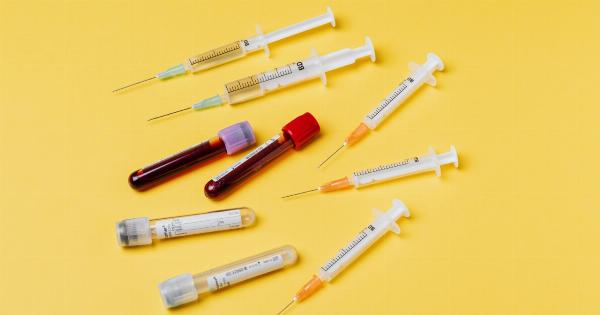Blood donation and transfusion programs are essential for maintaining the health of patients who require blood transfusions due to medical conditions or injuries.
These programs involve a series of steps ranging from blood donation to screening and testing before the blood can be used for transfusion. In this article, we will be discussing the different aspects of blood donation and transfusion program coverage that are critical for ensuring patient safety.
Blood Donation Process
The blood donation process is critical to ensure that the blood collected is safe for use in transfusions. The process involves the following steps:.
- Donor Selection: Donors are selected based on their age, health status, and medical history. Certain medical conditions and lifestyle choices may restrict an individual from donating blood.
- Blood Collection: Blood is collected from donors in a sterile environment using sterile needles and bags. The amount of blood collected varies depending on the donor’s weight and health status.
- Blood Testing: The collected blood is subjected to a battery of tests to ensure that it is free from infections such as HIV, Hepatitis B, and Hepatitis C.
- Blood Storage: The collected and tested blood is stored in blood banks under strict temperature controls.
The blood donation process is tightly regulated and monitored to ensure that the blood collected is safe for use in transfusions.
Blood Transfusion Process
The blood transfusion process involves the use of the collected blood for transfusion into patients who require the same. The following steps are involved:.
- Patient Selection: Patients who require blood transfusions are selected based on their medical condition and blood type.
- Blood Matching: The collected blood is cross-matched with the patient’s blood type to ensure compatibility before the transfusion.
- Blood Transfusion: The compatible blood is transfused into the patient under strict medical supervision.
The blood transfusion process is critical to ensure that patients receive the right blood type and that the blood transfusion is safe for the patient.
Blood Donor Eligibility Criteria
Blood donation programs have strict eligibility criteria to ensure that the collected blood is safe for use in transfusions.
Eligibility criteria for blood donors may vary based on local regulations and guidelines, but some of the common eligibility criteria include:.
- Age: Blood donors are typically required to be between the ages of 18 and 65, although this can vary based on local regulations.
- Weight: Donors must weigh at least 50 kg to donate blood.
- Health Status: Donors must be in good health and free from certain medical conditions such as HIV, Hepatitis, and other blood-borne illnesses.
- Lifestyle Choices: Certain lifestyle choices such as drug use and risky sexual behavior may restrict an individual from donating blood.
- Travel History: Individuals who have traveled to certain countries with endemic diseases may be restricted from donating blood for a certain period.
Donors who meet the eligibility criteria are closely screened and monitored to ensure that the collected blood is safe for use in transfusions.
Blood Testing and Screening
Blood testing and screening are essential to ensure that the donated blood is safe for use in transfusions. The collected blood is tested for infections such as HIV, Hepatitis B, and Hepatitis C, among others.
The following tests are commonly performed on donated blood:.
- Antibody Screening: Donated blood is screened for antibodies against HIV, Hepatitis B, Hepatitis C, and other infectious diseases. If antibodies are detected, the blood is discarded and deemed unsuitable for transfusion.
- Nucleic Acid Testing (NAT): NAT is used to detect the presence of genetic material from infectious agents in blood, including HIV and Hepatitis C. NAT testing is extremely sensitive and is required by many blood banks worldwide.
- Blood Grouping: Blood grouping is done to determine the blood type of the donor and ensure compatibility with the patient’s blood type.
Blood testing and screening are critical to ensure that the collected blood is safe for use in transfusions and does not pose any risk to the recipient.
Blood Transfusion Risks
Although blood transfusions are performed under strict medical supervision and with utmost care, there are still some risks associated with blood transfusions. Some of the potential risks of blood transfusions include:.
- Transfusion Reactions: Transfusion reactions occur when the recipient’s immune system attacks the transfused blood, leading to symptoms such as fever, chills, and shortness of breath.
- Infections: Although blood is thoroughly screened and tested, there is still a small risk of infections with blood transfusions.
- Blood Type Mismatch: Blood transfusions require strict blood typing and matching to avoid blood type mismatches that can lead to severe reactions and complications.
Despite these risks, the benefits of blood transfusion typically outweigh the potential risks, and blood transfusions continue to be an important medical intervention.
Blood Donation and Transfusion Program Coverage
Blood donation and transfusion programs are critical for ensuring that patients receive safe and timely blood transfusions when required. Blood donation and transfusion program coverage typically includes the following aspects:.
- Donor Recruitment: Blood donation programs rely on the recruitment of eligible donors who are willing to donate blood.
- Blood Collection: Collected blood is safely transported to blood banks and stored under appropriate temperature conditions.
- Blood Testing and Screening: Donated blood is thoroughly screened and tested for infections and blood type compatibility.
- Blood Storage: Collected blood is stored in blood banks and made available for transfusion when required.
- Blood Transfusion: Blood transfusions are performed under strict medical supervision and with utmost care to ensure that patients receive safe and timely transfusions.
- Blood Donor Management: Blood donation programs have protocols in place to closely monitor and manage blood donors to ensure that they are safe and healthy.
- Blood Supply Management: Blood supply management is critical to ensure that blood banks have adequate stocks of blood to meet patient needs.
Blood donation and transfusion program coverage is essential for maintaining the health and wellbeing of patients who require blood transfusions.
Governments, non-governmental organizations, and other stakeholders play a critical role in ensuring adequate coverage of blood donation and transfusion programs.
Conclusion
Blood donation and transfusion programs are critical for ensuring that patients receive safe and timely blood transfusions when required.
The blood donation and transfusion process are tightly regulated and monitored to ensure that the collected blood is safe for use in transfusions. Blood donation and transfusion program coverage includes donor recruitment, blood testing and screening, blood storage, blood transfusion, blood donor management, and blood supply management.
With adequate program coverage and stringent safety measures, blood transfusions remain a critical medical intervention for patients in need.




























